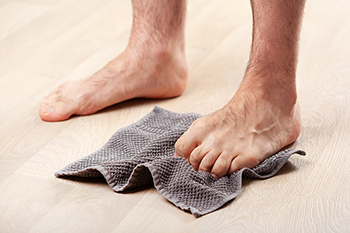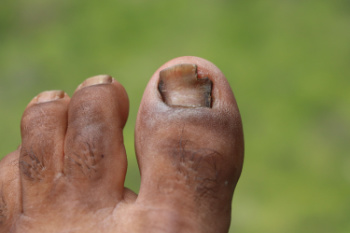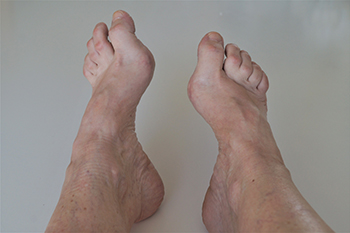Connect With Us
Blog
Items filtered by date: February 2024
Rehabilitation Exercises for a Broken Toe

Recovering from a broken toe can be a frustrating journey, but with the right exercises, you can expedite the healing process and regain strength and flexibility in your toe. Start with passive toe exercises, where you sit comfortably and use gentle movements to bend your toe forward and backward, gradually increasing flexibility. Toe curls help to strengthen the muscles surrounding the toe, promoting stability and mobility. Towel scrunches provide a great opportunity to work on grip strength and dexterity by using your toes to scrunch a towel towards you and then push it back. Marble pick-ups add a fun and challenging element to your routine as you aim to pick up marbles with your toes and place them into a cup, which improves coordination and control. Lastly, the towel stretch helps to elongate the muscles and tissues in the toe, enhancing flexibility and reducing stiffness. Consistency is key, so aim to incorporate these exercises into your daily routine to support a speedy recovery. If you need help in dealing with a broken toe, it is suggested that you make an appointment with a podiatrist.
Broken toes may cause a lot of pain and should be treated as soon as possible. If you have any concerns about your feet, contact one of our podiatrists from Comprehensive Foot & Ankle Centers. Our doctors will treat your foot and ankle needs.
What Is a Broken Toe?
A broken toe occurs when one or more of the toe bones of the foot are broken after an injury. Injuries such as stubbing your toe or dropping a heavy object on it may cause a toe fracture.
Symptoms of a Broken Toe
- Swelling
- Pain (with/without wearing shoes)
- Stiffness
- Nail Injury
Although the injured toe should be monitored daily, it is especially important to have a podiatrist look at your toe if you have severe symptoms. Some of these symptoms include worsening or new pain that is not relieved with medication, sores, redness, or open wounds near the toe.
If you have any questions, please feel free to contact our offices located in Shepherdsville and Louisville, KY . We offer the newest diagnostic and treatment technologies for all your foot care needs.
Professional Removal of Corns

Corns, small areas of thickened skin that develop on the feet due to friction or pressure, can cause discomfort and pain if left untreated. These hardened patches often form on areas of the feet subjected to repeated rubbing from ill-fitting shoes, abnormal foot mechanics, or prolonged standing. Corns can interfere with daily activities, and professional removal methods offer long-lasting solutions for persistent corns. Podiatrists and foot specialists employ various techniques to safely and effectively remove corns, depending on their severity and location. Common removal methods include paring, where the thickened skin is carefully trimmed using specialized instruments, and chemical treatments, such as salicylic acid solutions, to dissolve the hardened tissue. In cases where corns are deeply embedded or accompanied by underlying foot issues, podiatrists may recommend orthotic devices or corrective measures to alleviate pressure and prevent recurrence. Seeking professional care from a podiatrist for corn removal ensures proper treatment and reduces the risk of complications, promoting optimal foot health and comfort for individuals dealing with this foot ailment. If you have a corn on your foot, it is suggested that you schedule an appointment with a podiatrist who can successfully remove the corn, in addition to offering you effective prevention techniques.
Corns can make walking very painful and should be treated immediately. If you have questions regarding your feet and ankles, contact one of our podiatrists of Comprehensive Foot & Ankle Centers. Our doctors will treat your foot and ankle needs.
Corns: What Are They? And How Do You Get Rid of Them?
Corns are thickened areas on the skin that can become painful. They are caused by excessive pressure and friction on the skin. Corns press into the deeper layers of the skin and are usually round in shape.
Ways to Prevent Corns
There are many ways to get rid of painful corns such as:
- Wearing properly fitting shoes that have been measured by a professional
- Wearing shoes that are not sharply pointed or have high heels
- Wearing only shoes that offer support
Treating Corns
Although most corns slowly disappear when the friction or pressure stops, this isn’t always the case. Consult with your podiatrist to determine the best treatment option for your case of corns.
If you have any questions please feel free to contact our offices located in Shepherdsville and Louisville, KY . We offer the newest diagnostic and treatment technologies for all your foot and ankle needs.
Do Your Child's Feet Hurt?
How the Right Shoes Help Prevent Toenail Fungus
 Toenail fungus, a common and contagious nail infection, can be impacted by footwear. Understanding how shoes can contribute to toenail fungus is the first step toward the prevention and recurrence of fungal infections. Tight, ill-fitting shoes create the right environment for fungus to grow, because these shoes trap sweat and moisture and provide a warm, dark space. Airflow helps keep feet dry, but tighter shoes often don’t have good ventilation. On the other hand, breathable, moisture-wicking footwear can reduce the risk of toenail fungus. Fungal infections are contagious, so it’s best to avoid sharing shoes. Regularly disinfecting shoes can also help prevent the spread of fungal infections. Not only are your feet happier overall when you prioritize comfort, proper fit, and breathability in your shoes, but you also minimize the likelihood of toenail fungus taking hold and persisting. If you suspect toenail fungus, it is suggested you consult with a podiatrist who can provide a treatment plan and personalized recommendations for footwear.
Toenail fungus, a common and contagious nail infection, can be impacted by footwear. Understanding how shoes can contribute to toenail fungus is the first step toward the prevention and recurrence of fungal infections. Tight, ill-fitting shoes create the right environment for fungus to grow, because these shoes trap sweat and moisture and provide a warm, dark space. Airflow helps keep feet dry, but tighter shoes often don’t have good ventilation. On the other hand, breathable, moisture-wicking footwear can reduce the risk of toenail fungus. Fungal infections are contagious, so it’s best to avoid sharing shoes. Regularly disinfecting shoes can also help prevent the spread of fungal infections. Not only are your feet happier overall when you prioritize comfort, proper fit, and breathability in your shoes, but you also minimize the likelihood of toenail fungus taking hold and persisting. If you suspect toenail fungus, it is suggested you consult with a podiatrist who can provide a treatment plan and personalized recommendations for footwear.
For more information about treatment, contact one of our podiatrists of Comprehensive Foot & Ankle Centers. Our doctors can provide the care you need to keep you pain-free and on your feet.
Toenail Fungus Treatment
Toenail fungus is a condition that affects many people and can be especially hard to get rid of. Fortunately, there are several methods to go about treating and avoiding it.
Antifungals & Deterrence
Oral antifungal medicine has been shown to be effective in many cases. It is important to consult with a podiatrist to determine the proper regiment for you, or potentially explore other options.
Applying foot powder on the feet and shoes helps keep the feet free of moisture and sweat.
Sandals or open toed shoes – Wearing these will allow air movement and help keep feet dry. They also expose your feet to light, which fungus cannot tolerate. Socks with moisture wicking material also help as well.
If you have any questions please feel free to contact our offices located in Shepherdsville and Louisville, KY . We offer the newest diagnostic tools and technology to treat your foot and ankle needs.
Causes and Types of High Arches

Understanding pes cavus, commonly known as a high-arched foot, is essential for managing its impact on foot health, especially as you age and the risk of falls increases. Pes cavus can develop due to various reasons. Included are nerve conditions like Charcot-Marie-Tooth disease, spine issues, or past polio infections, leading to muscle imbalances and weakness in the feet and ankles. The three main types of pes cavus are when the heel is turned inward, pushed up, and when the arch is just very high. Each type has its own signs and can be seen on special X-rays. Symptoms of pes cavus can include foot pain, feeling unstable when walking, and having trouble finding comfortable shoes, which usually get worse as the arch gets higher. Treatment usually starts with non-surgical options like custom orthotics and exercises to improve balance. In more severe cases, surgery might be needed to fix the foot's shape and reduce pain. If you are experiencing foot pain or balance issues that may be related to high arches, it is suggested that you schedule an appointment with a podiatrist for an exam and diagnosis.
If you have any concerns about your feet, contact one of our podiatrists from Comprehensive Foot & Ankle Centers. Our doctors can provide the care you need to keep you pain-free and on your feet.
Biomechanics in Podiatry
Podiatric biomechanics is a particular sector of specialty podiatry with licensed practitioners who are trained to diagnose and treat conditions affecting the foot, ankle and lower leg. Biomechanics deals with the forces that act against the body, causing an interference with the biological structures. It focuses on the movement of the ankle, the foot and the forces that interact with them.
A History of Biomechanics
- Biomechanics dates back to the BC era in Egypt where evidence of professional foot care has been recorded.
- In 1974, biomechanics gained a higher profile from the studies of Merton Root, who claimed that by changing or controlling the forces between the ankle and the foot, corrections or conditions could be implemented to gain strength and coordination in the area.
Modern technological improvements are based on past theories and therapeutic processes that provide a better understanding of podiatric concepts for biomechanics. Computers can provide accurate information about the forces and patterns of the feet and lower legs.
Understanding biomechanics of the feet can help improve and eliminate pain, stopping further stress to the foot.
If you have any questions please feel free to contact our offices located in Shepherdsville and Louisville, KY . We offer the newest diagnostic and treatment technologies for all your foot and ankle needs.
Blog Archives
- July 2025
- June 2025
- May 2025
- April 2025
- March 2025
- February 2025
- January 2025
- December 2024
- November 2024
- October 2024
- September 2024
- August 2024
- July 2024
- June 2024
- May 2024
- April 2024
- March 2024
- February 2024
- January 2024
- December 2023
- November 2023
- October 2023
- September 2023
- August 2023
- July 2023
- June 2023
- May 2023
- April 2023
- March 2023
- February 2023
- January 2023
- December 2022
- November 2022
- October 2022
- September 2022
- August 2022
- July 2022
- June 2022
- May 2022
- April 2022
- March 2022
- February 2022
- January 2022
- December 2021
- November 2021
- October 2021
- September 2021
- August 2021
- July 2021
- June 2021
- May 2021
- April 2021
- February 2021
- January 2021
- December 2020

